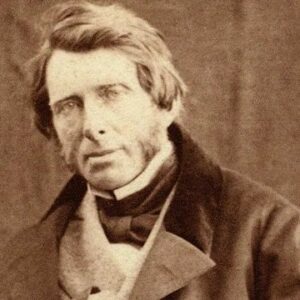John Ruskin was an English painter and art critic who lived during the Victorian era. He was a multi-faceted individual who wrote on a variety of subjects, including geology, architecture, myth, ornithology, literature, education, and political economy, among others. As a nature lover, he painted plants, birds, and landscapes frequently, and in his essays, he stressed the linkages between nature, art, and society. He had an early interest in art as the only son of a successful merchant, motivated mostly by his father’s collection of watercolor paintings. He was influenced as a young man by the paintings of J.M.W. Turner, John Constable, and John Sell Cotman, as well as the sermons of Charles Simeon, John Keble, Thomas Arnold, and John Henry Newman. He also traveled extensively, which influenced his artistic endeavors. He rose to prominence as the author of the first volume of ‘Modern Painters,’ a book on art critique. Because of the book’s popularity, he decided to publish more volumes in coming years. In addition to painting, he was well-versed in a variety of other areas. He also wrote a series of social essays for ‘Cornhill Magazine,’ which he later compiled as ‘Unto This Last,’ and contributed to ‘Fraser’s Magazine,’ where he wrote a series of articles on economic themes.
Childhood and Adolescence of John Ruskin
As the only child of John James Ruskin, a rich merchant, and his wife, Margaret Cox, John Ruskin was born on February 8, 1819 in London, England. Both of his parents had high hopes for their son.
His father, an art collector, instilled in him a love of Romanticism as a child. His mother, a devout Christian, instilled in him the habit of reading the King James Bible from beginning to end. His upbringing would have a lasting influence on his work as a painter and writer in the future.
1834 until 1835, he attended Thomas Dale’s progressive Evangelical school in Peckham, where he received his elementary education from his parents and private tutors. In 1836, he enrolled in the University of Oxford.
As a young guy, he also traveled extensively. His travels across the world broadened his understanding of the world and allowed him to witness nature in a variety of states. He kept notebooks since he was a child, in which he drew maps, landscapes, and structures.
By the mid-1830s, he was writing short prose and verse pieces in publications as a writer. In 1843, he published the first volume of his ‘Modern Painters’ series. He maintained in this work that modern landscape painters were superior to the so-called Old Masters of the post-Renaissance period.
The work was well-received, and he went on to publish four more volumes over the next 17 years. While the first volume focused on defending J.M.W. Turner’s latter work, the second volume focused on symbolism in art as represented through nature.
John Ruskin was equally fascinated by architecture, especially the Gothic revival. In 1849, he wrote ‘The Seven Lamps of Architecture,’ a book that outlined the seven moral characteristics that Ruskin believed were essential to and inextricably linked to all architecture: sacrifice, truth, power, beauty, life, memory, and obedience.
‘The King of the Golden River,’ his lone fairy tale, was published in 1851. It became an early Victorian classic, with three editions sold out. It was an illustrated story about how love, generosity, and goodwill triumphed against evil.
He drew copious sketches and notes between 1851 and 1853, which eventually constituted his three-volume opus, ‘The Stones of Venice.’ From a technical history of Venetian architecture from the Romanesque to the Renaissance, he expanded this work into a wide cultural history.
He presented his watercolors at the Fine Art Society and the Royal Society of Painters in Watercolour on occasion as an artist in the United States and England. His works of art were founded on meticulous botanical, geological, and architectural research.
He was also a well-known lecturer, and his popularity as a lecturer skyrocketed in the 1850s. He instructed the students in art and architecture. His lectures at the Manchester Art Treasures Exhibition in 1857 were published as ‘The Political Economy of Art’ and later as ‘A Joy Forever.’
Ruskin lectured at the University of Cambridge, the British Institution, the Working Men’s Institute, and the Royal Military Academy during the 1860s. In August 1869, he was named the first Slade Professor of Fine Art at Oxford University, and in 1871, he established The Ruskin School of Drawing and Fine Art at Oxford.
Major Projects of John Ruskin
From 1843 through 1860, he worked on a series of art books named ‘Modern Painters,’ in which he contended that contemporary painters were superior to the Old Masters in landscape painting. In total, he published five volumes in the series.
‘The Seven Lamps of Architecture,’ an extensive essay, formalized to some part the modern philosophy underlying the Gothic Revival. The word ‘lamps’ in the title refers to Ruskin’s architectural ideals. It was a huge hit with the public, and the Cambridge Camden Society, a group of ecclesiologists, endorsed it.
Personal History and Legacy
In 1847, John Ruskin married Effie Gray, the daughter of family friends. Ruskin penned ‘The King of the Golden River’ specifically for her. The following year, they married. Their marriage was never consummated because their partnership was not pleasant. It was later declared null and void.
When Ruskin was nearly 39, he fell in love with Rose La Touche, a ten-year-old girl. He proposed to her when she was 18, but she declined and requested that he wait until she was 21. She eventually rejected him and died after a protracted illness after a few years. Ruskin’s mental health deteriorated as a result of her death.
At the age of 80, he died of influenza on January 20, 1900.
Estimated Net Worth
Estimated net worth of John Ruskin is unknown.


